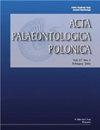Brachiopod fauna from upper Visean, Mississippian, mud mounds in Derbyshire, UK
IF 1.9
3区 地球科学
Q2 PALEONTOLOGY
引用次数: 2
Abstract
The systematic study of a brachiopod fauna collected from a Brigantian, uppermost Visean, Mississippian, mud mound complex on the Derbyshire Carbonate Platform (England, United Kingdom) recognises 45 species, representing 36 genera and seven orders (Productida, Orthotetida, Orthida, Rhynchonellida, Spiriferida, Spiriferinida, and Terebratulida). The mound complex is a decametre-scale lens-shaped buildup composed of three facies associations: the basal tabular unit made of skeletal packstone beds and tabular mounds, the complex core formed by metre-scale lens-shaped massive mounds and the surrounding inclined skeletal packstone flank beds. Brachiopods are widespread and very abundant in all three facies associations. Spinose, concavo–convex productides are dominant in the mud mound fauna, both in terms of the number of specimens, species, and biovolume. Productide success is related to scattered and scarce food resources, which they better exploited using their simple, unsupported feeding apparatus in comparison with that of the spiriferides. Spiriferides with a wide interarea are common and large in the basal tabular unit, but are rare and small in the complex core, probably due to greater availability of food resources during the deposition of the basal unit. Substrate type also played a role in controlling brachiopod diversity: varied substrates in the mound complex core allowed small-sized pedicle-attached rhynchonellides, spiriferides, and terebratulides to extensively colonise the seafloor, whereas they are rare in the basal unit.英国德比郡的上维桑,密西西比,泥丘的腕足动物群
对英国德比郡碳酸盐岩台地上布里安阶、上维西阶、密西阶泥丘复群的腕足动物区系进行了系统研究,鉴定出7目(Productida、Orthotetida、Orthida、Rhynchonellida、Spiriferida、Spiriferinida和Terebratulida) 36属45种。丘状杂岩是由3种相组合组成的10米尺度透镜状堆积体:由骨状包岩层和板状丘组成的基底板状单元,由米尺度透镜状块状丘组成的复杂岩心和周围倾斜的骨状包岩侧层。在这三种相组合中,腕足动物分布广泛,数量非常丰富。在泥丘动物群中,无论是在标本数量、物种数量还是生物数量上,棘状、凹凸状的产物都占主导地位。生产的成功与分散和稀缺的食物资源有关,与螺旋体相比,它们使用简单、无辅助的取食装置可以更好地利用食物资源。具有宽间距的spirifiides在基板单元中常见且较大,但在复杂核心中罕见且较小,这可能是由于基板单元沉积期间食物资源的更大可用性。底物类型也在控制腕足动物多样性方面发挥了作用:丘堆复合体核心中不同的底物允许小型的带蒂的rhynchonellides、spiriferides和terebratulides广泛地在海底定居,而它们在基单元中却很少见。
本文章由计算机程序翻译,如有差异,请以英文原文为准。
求助全文
约1分钟内获得全文
求助全文
来源期刊

Acta Palaeontologica Polonica
地学-古生物学
CiteScore
2.80
自引率
5.60%
发文量
36
审稿时长
12.5 months
期刊介绍:
Acta Palaeontologica Polonica is an international quarterly journal publishing papers of general interest from all areas of paleontology. Since its founding by Roman Kozłowski in 1956, various currents of modern paleontology have been represented in the contents of the journal, especially those rooted in biologically oriented paleontology, an area he helped establish.
In-depth studies of all kinds of fossils, of the mode of life of ancient organisms and structure of their skeletons are welcome, as those offering stratigraphically ordered evidence of evolution. Work on vertebrates and applications of fossil evidence to developmental studies, both ontogeny and astogeny of clonal organisms, have a long tradition in our journal. Evolution of the biosphere and its ecosystems, as inferred from geochemical evidence, has also been the focus of studies published in the journal.
 求助内容:
求助内容: 应助结果提醒方式:
应助结果提醒方式:


